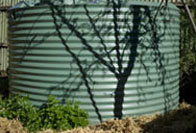Plastic (usually Polyethylene)

Plastic water tanks are the most common type of tank available. They are light and can be easily transported and moved around a property. They also come in the widest range of styles, shapes and colours.
Cost:
Standard round polyethylene (poly) tanks are generally the cheapest tanks available. You will get a better price per litre the larger the tank you buy, so it is often worth buying all your tank storage in one hit rather than in stages.
Please see the Price Comparison for price estimates.
Deterioration/life span/durability:
Most poly tanks will degrade over time with sun exposure despite having UV inhibitors added to the plastic. There are limits to how much UV inhibitor can be added to the polyethylene. Most manufacturers will provide a repair service for their tanks if it is needed. This being said, poly tanks are generally weldable by any plastic fabricator with the right equipment. If you are on bore water, poly tanks may be your best option as they are relatively resistant to damage from saline water.
Sizes and shapes:
Poly tanks come in a huge range of colours and styles, including round, modular and bladder. For high-density living, modular tanks or bladder tanks under floors can be the best solution. Bladder tanks consist of a metal frame around a flexible plastic or rubber bladder and can be suitable for houses mounted on stumps or post-mounted decking. There are also a number of underground poly tank solutions, such as crate systems that stack together inside an impermeable liner. Some underground poly tanks are also well reinforced and can withstand considerable loads, although for larger underground tanks (over about 10,000L), concrete tanks or crate systems may be a better solution.
Water quality:
All water tanks sold in Australia must comply with Standards Australia's requirements for the use of products in contact with drinking water (AS/NZS4020:2005). Poly tanks also have their own manufacturing standard, known as the AS/NZ4766:2006, which covers all aspects of the tank's design and manufacture. Be aware that some bladder tanks use PVC bladders. If you intend to drink the water from a bladder tank, make sure the bladder is rated as a potable water bladder. If you are only using the water on the garden then this probably won't be an issue.
Environmental credentials:
If a poly tank has degraded to a point where it can no longer hold water the plastic can only be recycled into a limited range of other products. Unless you can find a local recycling system for poly tanks, they will most likely end up in landfill. The density of plastic tank walls also means they carry more embodied energy than you might think.
Site preparation:
Compacted packing sand is generally fine for plastic tanks. If, however, you have rigid fixed plumbing and large tanks it may be worth considering a reinforced concrete base to avoid movement and the risk of damaging fixed plumbing.
We find that water stored in plastic tanks does not taste as good as water from unlined iron or concrete tanks, meaning that the tanks need to be cleaned every couple of years.
Very happy with the plastic tanks - very strong but light - easy to install and move - very long lasting